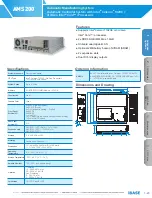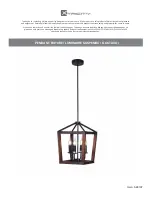
Table of Contents
Rev. 10/8/2021
P-HOP, MANUAL
Table of Contents
Copyright 2021 Vestil Manufacturing Corp. Page 9 of 12
1.
Dump the contents of the hopper by releasing the chute. To release the chute, pull the release cable.
The hopper will pivot about the dump axis and release the contents.
WARNING
DO NOT wrap the release cable around your hand/fingers or attach the handle to your clothing!
2.
Latch the chute to the base.
a.
Manually: slowly lower the forks until the hopper rests on the ground. The chute will pivot towards the
frame. Press the back end of the chute onto the base until the latch lever engages the latch bar. See
Diagram 1.
b.
Remotely (using the side of the dumpster): Raise the fork tips by tilting the forklift mast toward the cab.
Then, back away from the dumpster. Slowly lower the forks until the front end of the chute contacts to
top of the dumpster. Continue to slowly lower the forks until the chute pivots onto the base frame. You
should hear the latch lever snap over the latch bar. Confirm that the chute is securely latched by raising
the forks. The chute should not rotate. If necessary, lower the forks completely and manually latch the
chute to the frame.
3.
Lock the latch by reversing the process of step 3. DO NOT move the hopper until the latch is locked!
CASTER BRAKE
Each P-HOP series hopper has 2 swiveling
casters in back, one of which is equipped with a
brake. To engage the brake, press the brake
lever down. When the brake is engaged the
wheel will not rotate. To disengage the brake, lift
the brake lever up.
RECORD OF SATISFACTORY CONDITION
Before using this hopper for the first time, create a record OF its appearance and features. Include
descriptions of the chute, base, carriage chain and quick link, pivot points and pivot point hardware,
casters, caster mounting hardware, and the chute release mechanism. Release the chute. Describe how
the unit looks and sounds as the chute rotates. Also describe the force necessary to release the chute using
both the manual release lever and the cable. Secure the chute to the base and describe how the latch
mechanism works. Thoroughly photograph the unit and all labels applied to it. Collect all writings and
photographs in a single file. This file is a record of the unit in satisfactory condition.
Compare all inspection
results to this
RECORD
to determine if the unit is in satisfactory condition.
Restore the hopper to satisfactory
condition BEFORE using it again
.
Purely cosmetic changes, like damaged surface coating (paint or
powdercoat) are not changes from satisfactory condition. However, touchup paint should be applied as
soon as damage occurs to prevent rusting.
INSPECTIONS & MAINTENANCE
Inspections and repairs should only be performed by qualified persons. Compare the results of each
inspection to the
RECORD
OF SATISFACTORY CONDITION
(the “RECORD”). Do not use the hopper unless all
parts are in satisfactory condition. Replace parts that are not in satisfactory condition before using the
hopper again.
DON’T GUESS!
If you have any questions about the condition of your hopper, speak with
TECHNICAL SERVICE
personnel
.
The phone number is provided on the cover page of this manual.
Never
make temporary repairs of damaged or missing parts
. Only use manufacturer-approved replacement
parts.
Inspections [refer to applicable
, or
]:
(A)
Before each use inspect the following components:
1.)
Release cable – look for fraying, birdcaging, thinning.
2.)
Hopper chute or base frame – check for damage, deformation, corrosion or severely rusted regions.
3.)
Pivot points – as the chute rotates (after releasing it), listen for unusual noise and watch for binding as
the chute rotates. Also look for distortion of the axle pins or axle receivers.
Brake
lever
!






























